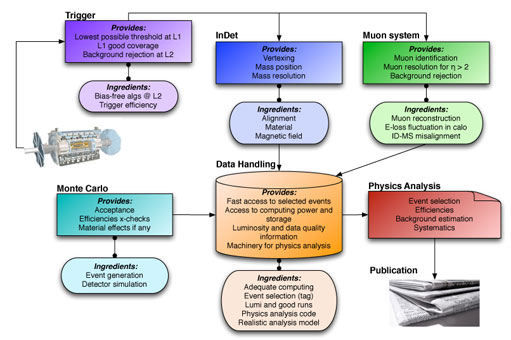
ATLAS e-News
23 February 2011
Analysis walkthrough seen from the inside
2 November 2009

The roadmap for J/psi analysis
So. Things are looking good in the pit and the software is being polished to within an inch of its life… Time to take a look at the ultimate end: getting the best possible results fast, hopefully before others. The so-called ‘Analysis Readiness Walkthroughs’ have been conceived as a way to check how well-oiled the various components of the ATLAS discovery engine are, and to road test the whole shebang before the pressure is on for real.
First outlined in late July, the idea behind the walkthroughs is to build step-by-step ‘road maps’ – from trigger to publication – of some of the very early analyses, in order to highlight areas that are lacking or need improving. The ultimate aim is to whip the analyses into shape, so that they’ll be as simple and fast as possible once collisions begin.
The exercise brings together experts from all over ATLAS; each analysis is prepared by four or five ‘contact physicists’ and picked apart by a review committee made up of a further five or so experts, during an intense day of presentations and discussions. Building a coherent picture of how an analysis will run from start to finish is essential in practical terms, as it suddenly throws into relief all the tiny imperfections in the chain, which may otherwise have slipped through the net.
Samira Hassani, a muon reconstruction specialist and at that time co-convenor of the B-Physics group, was a contact physicist in the first walkthrough to take place: the J/Psi to dimuon analysis. Being the first group to go, they were initially unsure of the motives for the exercise:
“We thought that it was like an exam,” she recalls, “presenting already known information in a certain format, and asking ‘what I’m missing? What do I understand?’ for the review committee to judge.”
Indeed, it sounds suspiciously like an exam scenario, but in this case it was ATLAS as a whole under scrutiny, and not the work or understanding of the individual contact physicists.
Much work went into planning the walkthrough in the four weeks ahead of the big day on August 31st. The J/Psi group defined five key areas to present on: Trigger, Inner Detector, the Muon system, data handling and physics analysis. They identified what each of these steps in the analysis chain provides, the ‘ingredients’ needed for it to function as intended, where they are currently falling short, and what needs to be done to get everything up to speed. Before the walkthrough, they spent three days rehearsing together to ensure that it all ran smoothly and that nothing was duplicated between their talks.
The morning of the 31st was taken up with the five presentations and questions from the floor. The review committee and the ATLAS management met for two hours of closed discussion that afternoon, after which their recommendations were announced to the public meeting.
“The spirit of the meeting was very positive, not aggressive at all,” according to Samira. “These people were not there to judge us, but really to help us – to give us suggestions and ideas.”
In fact, Samira found the experience to be positive from multiple angles. The room was packed with people from every area of the collaboration, all eager to ask questions. In fact, Aleandro Nisati, as Chair of the meeting, had to curtail the sessions in some instances, due to the tight time constraints of the day.
“It was unlike normal ATLAS working meetings, where you show progress,” explains Samira. “Usually, unless you’re really involved in the subject, you don’t ask questions. But here, since you present to people a global picture, they can ask questions because they can understand [the background].”
“We’re not always aware about what everyone in ATLAS is doing,” she adds, “so this was an opportunity to show others what we’re doing, what are the expected performances, and what we can do with first data.” It was also a chance to highlight areas where more people are required and, in the wake of the walkthrough, offers of help have been coming thick and fast.
Finally, the working links established between the contact physicists and the review committee will prove invaluable when real data does arrive, when more discussion might be necessary: “If we’re lucky and find [the J/psi peak] in the good position with the correct width and so on, we’re happy. If it’s not the case, we can’t publish, because there’s something that we don’t understand in the chain.”
At the time of publication, two further walkthroughs have taken place – one for Min Bias and one for muon jets – and a fourth, an electron analysis, is chalked up for November 9th.

Ceri PerkinsATLAS e-News
|